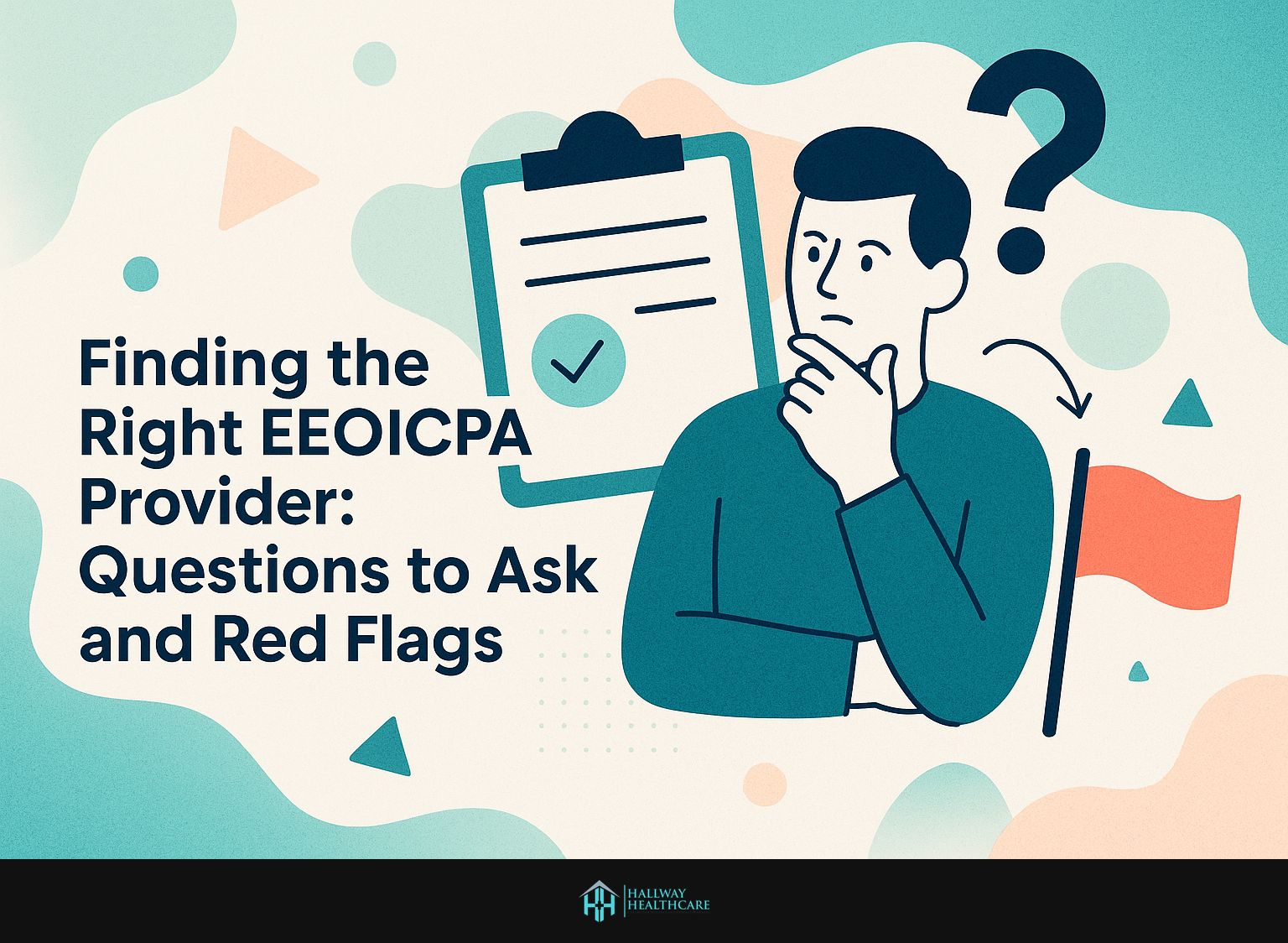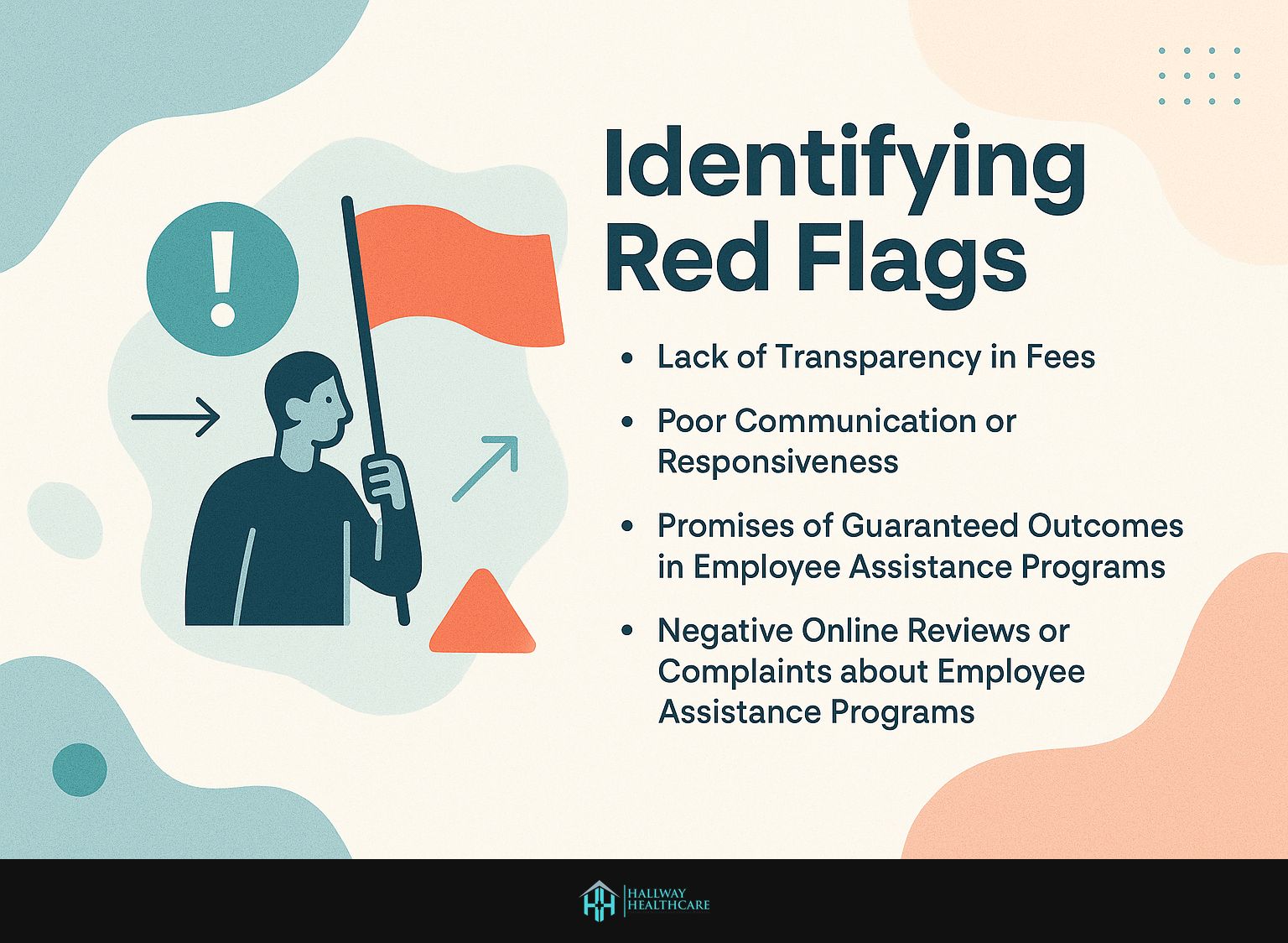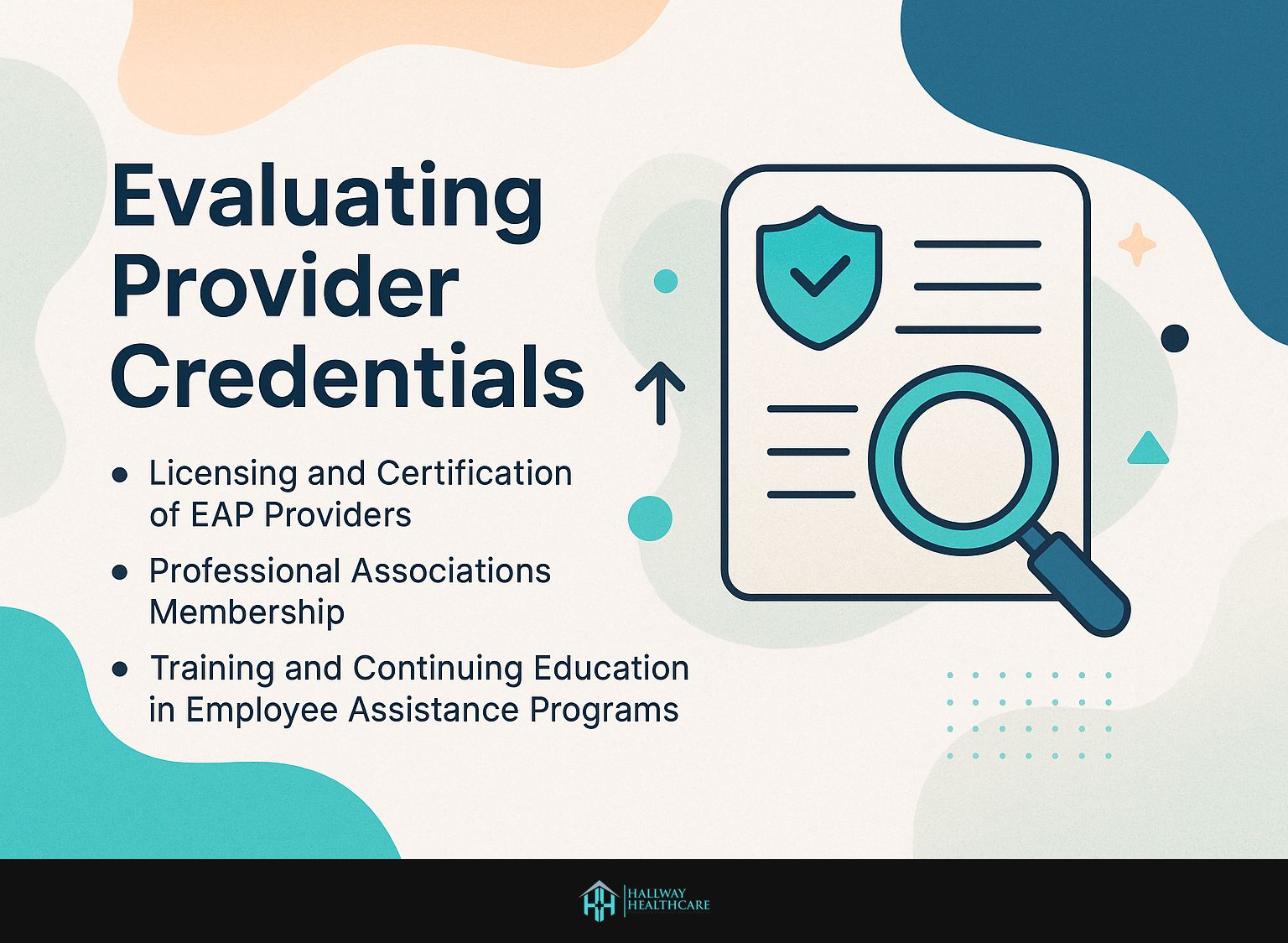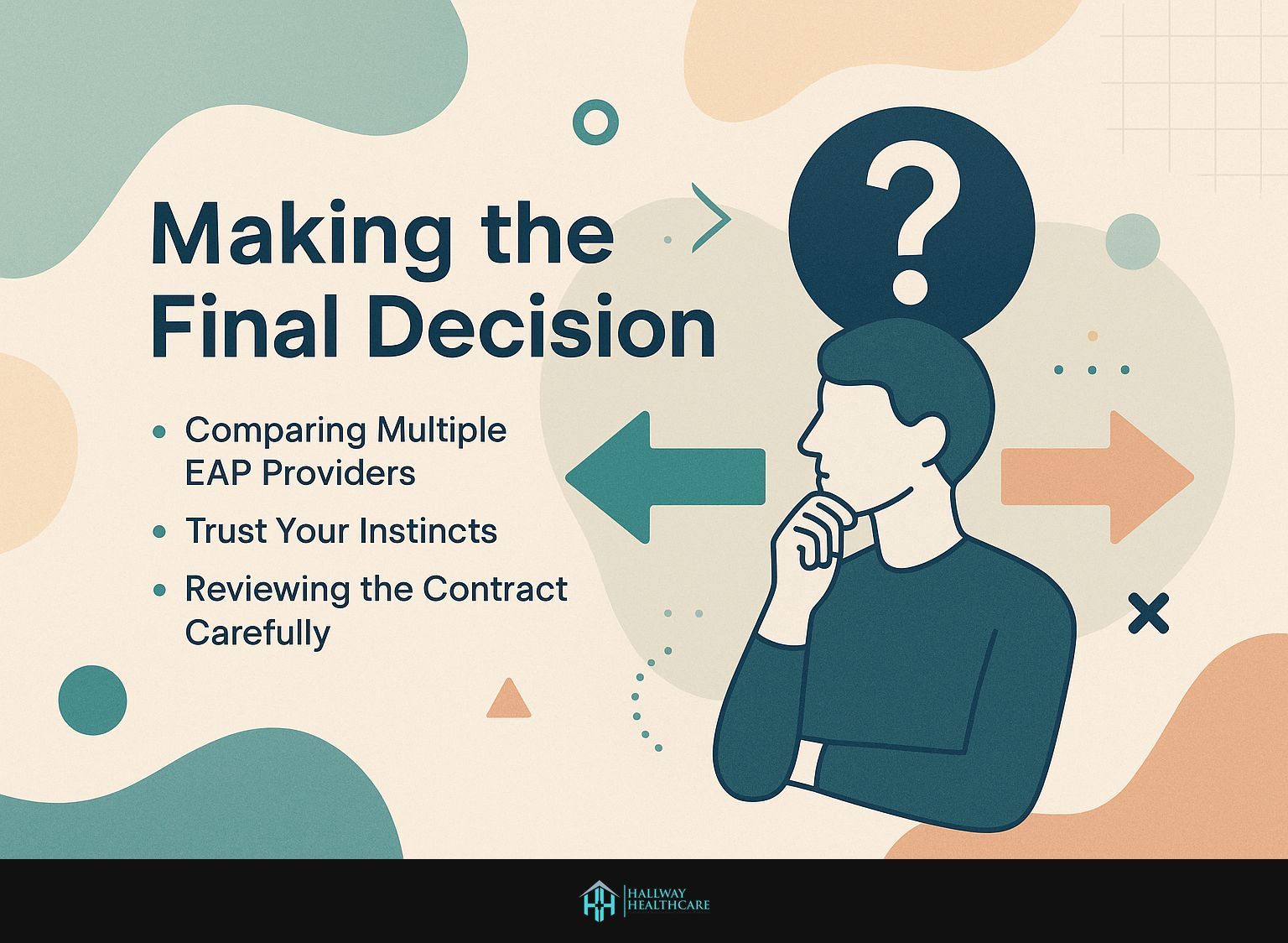
Navigating the complexities of the EEOICPA can be daunting. Selecting the right provider for your needs is crucial. Learning about the Ulliance difference in Employee Assistance Programs can boost employee well-being. This is especially true for those facing substance abuse and mental health challenges. With insights from a Master of Social Work and Master of Arts in Counseling, this article will guide you through essential questions to ask potential providers and highlight red flags to watch for, ensuring you find a partner committed to effective support.
Key Takeaways:
- Choose an experienced EEOICPA provider with a high success rate in claims and transparent communication process, including customized wellness programs and employee communication strategies.
- Look out for red flags like hidden fees, poor communication, and promises of guaranteed outcomes.
- Evaluate credentials of potential providers and trust your instincts when making the final decision.
What is EEOICPA?
The Energy Employees Occupational Illness Compensation Program Act (EEOICPA) is a federal initiative aimed at compensating employees who have experienced health issues as a result of exposure to toxic substances in the workplace.
Administered by the U.S. Department of Labor, including the Office of Worker Compensation Programs, the EEOICPA provides a range of benefits, including coverage for medical treatment, compensation for wage loss, and benefits for survivors.
Every year, over 100,000 claims are processed. Many of these result in awards for medical expenses and lost wages.
To initiate the application process, individuals may submit claims through the Department of Labor’s website or seek assistance from local resources, such as support centers that specialize in worker rights.
Collecting medical records and employment history, possibly consulting a medical second opinion, in advance can help streamline the process and improve the chances of approval.
Importance of Choosing the Right Provider
Choosing the right Employee Assistance Program (EAP) provider is vital. It can greatly affect how EEOICPA claims are managed and employee well-being outcomes.
A good EAP provider offers timely support and expert guidance. They provide access to counselors for short-term help and manager training.
For instance, a provider with a dedicated claims specialist can assist employees in gathering the necessary documentation and understanding their rights, thereby minimizing confusion.
Moreover, tools such as secure online portals enable direct communication, ensuring that inquiries are addressed promptly. Recent studies show that organizations using experienced EAP providers see a 30% boost in claim approvals.
Therefore, it is advisable to consider EAPs that provide comprehensive training for their staff, establish clear communication protocols, and prioritize timely resolutions to improve recovery rates.
Key Questions to Ask Potential Providers
When assessing potential EAP providers, ask the right questions. This ensures they meet the specific needs of employees navigating EEOICPA claims.

1. How Experienced Are You with Claims?
Knowing a provider’s experience with EEOICPA claims is vital. It shows their ability to handle complex cases effectively, including involvement with claims examiners and case managers.
When evaluating a provider, it is important to consider their duration of experience, success rate, and client testimonials. A reputable firm typically presents case studies that showcase their achievements, particularly in challenging claims. It is advisable to select providers with a minimum of five years of experience and at least 100 successfully handled claims.
Additionally, transparency in fees and processes is essential. Engaging with well-reviewed professionals can significantly enhance the likelihood of achieving a favorable outcome.
3. What is Your Success Rate?
Inquiring about a provider’s success rate with EEOICPA claims can provide valuable insights into their effectiveness and commitment to achieving favorable outcomes for clients.
To assess a provider’s effectiveness, ask about their historical success rates. Ideally, these should exceed 80%.
Request data on various claim types, like those related to hazardous exposure or survivor compensation, to understand their experience with different scenarios.
Inquire about the average processing times for claims. A swift turnaround may indicate a streamlined approach. Requesting customer testimonials or case studies can further illuminate their level of client support.
These steps will assist in evaluating the provider’s capability to navigate the complexities of EEOICPA claims effectively.
4. What Services Do You Offer?
Understanding the range of services provided by an Employee Assistance Program (EAP) provider is essential for delivering comprehensive support to employees navigating work-life challenges.
Key services to consider include Critical Incident Stress Debriefings, Smart Manager webinars, and customized wellness programs:
- Solution-focused counseling, which addresses immediate personal issues.
- Substance abuse support that offers intervention strategies.
- Wellness programs aimed at promoting overall health and resilience.
Ensure that there is a service specifically designed to address emotional difficulties, such as stress management workshops or crisis counseling. Choosing a provider that covers these areas helps create a healthier workplace. It also provides better support for employees facing challenges.
5. How Do You Charge for Your Services?
Clarifying the fee structure of Employee Assistance Program (EAP) providers is essential. This helps organizations budget effectively and avoid unexpected costs related to employee well-being, including investing in EAP and employee communication strategies.
It is advisable to begin by requesting a detailed breakdown of costs from at least three providers, with a focus on setup fees, monthly retainers, and any per-use charges.
- For instance, Provider A may impose a setup fee of $1,500 with a monthly rate of $500.
- Whereas Provider B may offer a lower setup fee of $1,000 but charge a higher monthly fee of $750.
Additionally, inquire about hidden fees, like costs for adding new employees or accessing specific services. This comprehensive comparison will enable organizations to select an EAP that aligns with both their budgetary constraints and the needs of their employees.
6. What is Your Communication Process?
A transparent communication process is essential for providing a seamless experience for employees accessing Employee Assistance Program (EAP) services and navigating Energy Employees Occupational Illness Compensation Program Act (EEOICPA) claims.
Implement regular updates, such as monthly newsletters or dedicated email communications, to keep employees informed about available EAP services and any changes in EEOICPA claims processing.
In addition, utilizing collaboration tools like Slack or Microsoft Teams can enhance real-time communication with Human Resources representatives, enabling staff to pose inquiries and receive prompt responses.
Create a designated FAQ section on the company intranet. This can address common concerns and clarify procedures, helping employees feel supported and informed.
Identifying Red Flags in Employee Assistance Programs
Identifying warning signs in prospective Employee Assistance Program (EAP) providers is essential for avoiding costly errors and fostering a supportive environment for employees who are experiencing challenges.

1. Lack of Transparency in Fees
A lack of transparency in fees can serve as a significant warning signal, suggesting the presence of potential hidden costs that may impose financial strain on organizations. To prevent unexpected expenses, organizations should request detailed pricing sheets prior to making any commitments.
Common hidden fees include:
- Setup charges
- Cancellation fees
- Additional costs for exceeding usage limits
For example, a provider may advertise low monthly rates. However, they might impose a $100 setup fee and charge $20 for every 1,000 emails sent beyond the established limit.
Document all discussions in writing. This practice reduces misunderstandings and establishes a clear foundation for the financial terms of the partnership.
2. Poor Communication or Responsiveness
Providers that demonstrate inadequate communication or slow responsiveness may not prioritize employee needs, adversely affecting overall satisfaction and the outcomes of claims.
To effectively evaluate communication during the initial consultation, it is advisable to implement a scoring system. Potential providers can be rated on a scale of 1 to 5, taking into account factors such as the timeliness of responses, clarity of explanations, and willingness to address inquiries.
For instance, if a provider responds within 24 hours and thoroughly addresses all questions, they should receive a score of 5.
This approach not only aids in identifying dependable partners but also establishes clear expectations for ongoing communication, ultimately enhancing employee satisfaction and improving the efficiency of claim processing.
4. Beware of Guaranteed Outcomes
Providers that guarantee specific outcomes in Employee Assistance Programs may make unrealistic claims. Approach such promises skeptically.
Start by researching the provider’s history. Look for reviews, case studies, and client testimonials, especially about employee well-being outcomes.
Utilize tools like Trustpilot and the Better Business Bureau for insights into the validity of their claims. Ensure that the provider presents clear terms of service and realistic timelines. A reputable provider typically outlines potential risks and provides scenarios that illustrate various outcomes.
By gathering this information, you can make a well-informed decision that aligns with your expectations and minimizes the risk of disappointment, especially when considering Critical Incident Stress Debriefings and conflict resolution services.
5. Negative Online Reviews or Complaints
Negative online reviews or a significant number of complaints can indicate subpar service quality, especially concerning work stress and marital problems, and warrant a closer examination of a provider’s reputation.
To begin, it is advisable to search for reviews on platforms such as Google and Yelp. Pay attention to consistent patterns in the feedback; if multiple reviews highlight similar issues, such as delayed service or unresponsive customer support, this should be duly noted.
Additionally, consider reaching out to former clients for honest testimonials regarding their experiences. This approach can yield invaluable insights into the provider’s reliability and service quality.
In conclusion, to avoid pitfalls, conduct a comprehensive review process. This ensures you partner with a reputable service provider.
Evaluating Provider Credentials
Evaluate an EAP provider’s credentials to ensure they meet industry standards. This shows compliance with industry regulations.

1. Licensing and Certification of EAP Providers
Confirm that an Employee Assistance Program (EAP) provider has the necessary licenses and certifications, such as a Master of Social Work or Master of Arts in Counseling. This shows compliance with industry regulations.
Begin by verifying critical credentials, such as the Licensed Professional Counselor (LPC) designation and the National Certified Counselor (NCC) certification. These qualifications indicate the provider’s adherence to professional standards.
Additionally, consult your state licensing board to ensure that the EAP provider is listed and in good standing. It is also beneficial to check for affiliations with recognized organizations, such as the Employee Assistance Professional Association (EAPAA), as these affiliations further demonstrate the provider’s commitment to maintaining high standards of care.
2. Professional Associations Membership
Joining professional associations shows a provider’s commitment to ongoing education and adherence to industry standards.
These organizations offer valuable resources such as training programs, credentials, and networking opportunities.
For example, the Employee Assistance Professional Association (EAPA) offers certification programs that enhance professional credibility. Joining local chapters helps build relationships with peers and keeps you updated on best practices.
Additionally, providers can gain exclusive access to research and toolkits that improve service delivery and keep them informed about industry trends.
3. Training and Continuing Education in Employee Assistance Programs
Assessing the training and continuing education programs from an EAP provider shows their commitment to best practices in employee assistance, including welfare coaching and substance abuse counseling.
Ask about specific training types for staff, such as trauma-informed care and mental health first aid. Understanding how often these training sessions occur is crucial. Monthly workshops indicate a strong commitment to improvement.
Furthermore, investigate if specialized training is available in areas relevant to your organization, like substance abuse counseling or crisis intervention. A provider that values continuous education with practical applications can greatly improve service quality for employees.
How to Make the Final Decision
Select an Employee Assistance Program (EAP) provider after careful evaluation to ensure the best fit for your organization.

1. Comparing Multiple EAP Providers
Comparing multiple Employee Assistance Program (EAP) providers helps organizations make informed decisions based on specific criteria and needs.
To evaluate EAP providers effectively, consider these key aspects: range of services, pricing structures, and client satisfaction ratings.
For instance, Provider A offers comprehensive mental health support and crisis intervention at $3 per employee per month. In contrast, Provider B focuses on wellness programs for $4. Provider C might offer a basic package at $2, but it includes limited personal counseling sessions.
Additionally, conducting a survey among employees can provide valuable insights into the support options they want, helping tailor the selection to your organization’s needs.
2. Follow Your Instincts
Trusting your instincts is crucial when selecting an Employee Assistance Program (EAP) provider. Intuitive feelings often reflect underlying concerns or confidence levels, especially regarding the Ulliance Difference and Smart Manager webinars.
Evaluate potential providers based on their communication style and responsiveness. Schedule initial meetings with at least three EAPs.
During these discussions, pay attention to how they address your questions and concerns. A provider that shows openness and transparency is likely to foster a productive long-term relationship.
Additionally, review client testimonials or case studies. Investigating their experience with similar organizations can give valuable insights into their understanding of your specific needs and culture.
3. Carefully Review the Contract
Review the contract with the selected Employee Assistance Program (EAP) provider carefully. This ensures clarity about the obligations of both parties and the services provided.
This review should cover crucial areas, including terms and conditions that detail specific service deliverables. Pay attention to key performance indicators (KPIs) used to assess the program’s effectiveness. Also, review exit clauses outlining how either party can terminate the agreement.
Consult legal advisors to understand complex terms.
This helps reduce risks and builds a strong partnership.
 Skip to content
Skip to content
